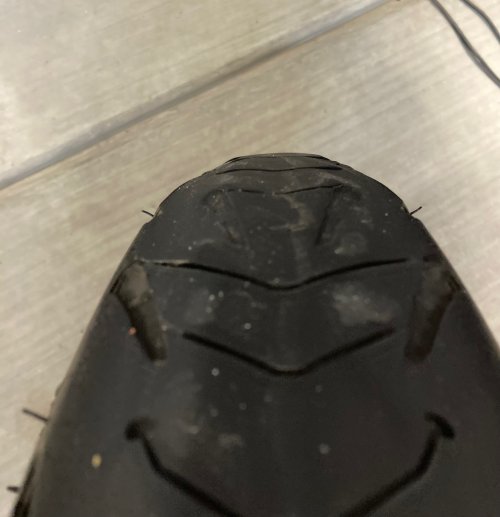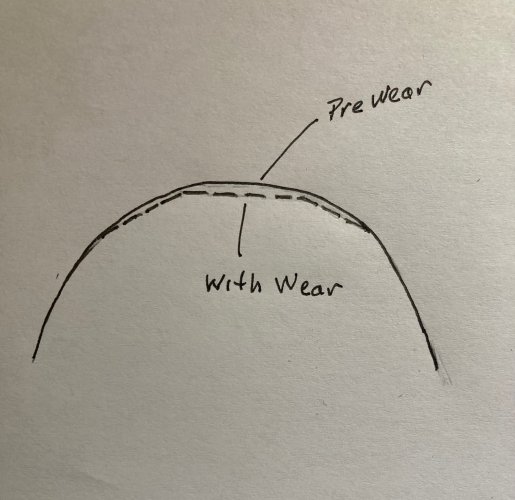I did go through several pages of the search on this, then stopped.
I share a photo and my sketch of the impression of the tire cross-section.
I did own an F850 GSA and now own an R1250 GS, an R1250 R and an R nineT Scrambler. Although only back into bikes 2.5 years ago after several decades away, I have now ridden close to 60k miles. But only experiencing the subject line issue of the R with Michelin tires.
2023 R1250R with Michelin Road 5 GT Tires. Currently around 16k miles on the tires and not yet to wear bar, but getting close. I do monitor TPM/TFT and although my pencil pressure gauge, versus my Dewalt portable air compressor, versus the bike TPM all read different by a couple psi, I tend to keep the tire pressure within +/- 1 psi based on TPM/TFT.
You can see the photo of the tire. And my sketch, where I have shown a smooth cross-section profile and the dashed line angled profile. My eye view of the tire profile is more like the dashed line, although the drawing may be exaggerating the degree.
When the tire is cold and I just start to pull away from the house and am turning at a slow speed, the steering seems to want to take control from me and pull in and I have to kinda fight it back out. Has been doing so for quite some time. I wonder if this is a result of the transition from the flat crown to the flat side across the break in curvature? Once the tire warms up and I am riding at speed and going into curves I really don't feel anything.
I also have a Kawasaki KLX 300 that had very odd, notchy, steering when new. On the break in service the technician indicated he had to grease the steering head and that the head bolt was too tight from the factory. When I had the R1250 R in for the 12,000 mile service I asked them to check the steering and they claimed it was fine. I had asked the same at the 6,000 mi service but they did not test ride "because it was raining".
So, what do you think. The flat crown to flat side across the break in curvature is causing it to pull and tuck in harder?
I share a photo and my sketch of the impression of the tire cross-section.
I did own an F850 GSA and now own an R1250 GS, an R1250 R and an R nineT Scrambler. Although only back into bikes 2.5 years ago after several decades away, I have now ridden close to 60k miles. But only experiencing the subject line issue of the R with Michelin tires.
2023 R1250R with Michelin Road 5 GT Tires. Currently around 16k miles on the tires and not yet to wear bar, but getting close. I do monitor TPM/TFT and although my pencil pressure gauge, versus my Dewalt portable air compressor, versus the bike TPM all read different by a couple psi, I tend to keep the tire pressure within +/- 1 psi based on TPM/TFT.
You can see the photo of the tire. And my sketch, where I have shown a smooth cross-section profile and the dashed line angled profile. My eye view of the tire profile is more like the dashed line, although the drawing may be exaggerating the degree.
When the tire is cold and I just start to pull away from the house and am turning at a slow speed, the steering seems to want to take control from me and pull in and I have to kinda fight it back out. Has been doing so for quite some time. I wonder if this is a result of the transition from the flat crown to the flat side across the break in curvature? Once the tire warms up and I am riding at speed and going into curves I really don't feel anything.
I also have a Kawasaki KLX 300 that had very odd, notchy, steering when new. On the break in service the technician indicated he had to grease the steering head and that the head bolt was too tight from the factory. When I had the R1250 R in for the 12,000 mile service I asked them to check the steering and they claimed it was fine. I had asked the same at the 6,000 mi service but they did not test ride "because it was raining".
So, what do you think. The flat crown to flat side across the break in curvature is causing it to pull and tuck in harder?
Attachments
Last edited:



